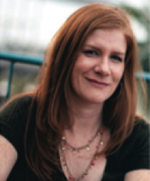A Steward of Sustainable Development
/ Her friends took lunch to school in paper bags. Sarah Hughes used Tupperware. They cleaned their homes with commercial detergent. Sarah’s mom, Anne, stuck with vinegar.
Her friends took lunch to school in paper bags. Sarah Hughes used Tupperware. They cleaned their homes with commercial detergent. Sarah’s mom, Anne, stuck with vinegar.
“It’s not like we were hippies, but I did grow up on a wooded acreage, more of a natural setting,” said Hughes, who is from Newmarket, Ont.
“My mother is aware of the environment. My grandmother taught me about different birds and wildflowers. In my high school yearbook, for my probable job I said I think I’ll be an environmental scientist.”
Hughes reaches for the sky.
She is an ecotoxicologist studying the effects of chemicals in the air we breathe, in the water we drink and in the soil where our food grows. She does environmental hazard and risk assessment for Shell. The energy and petrochemical company hired her after she completed the toxicology graduate program at the University of Saskatchewan.
Hughes (MSc’05, PhD’08) is one of Shell’s three ecotoxicologists in Houston, Texas. The other six are in England. Together they support Shell’s activities in more than 70 countries, reviewing company research and testing new materials and planned projects. Their motto is “scrub clean,” making sure business follows the environmental rules governments set for industry.
“On any given day I might work on five different projects,” said Hughes. “Every chemical is different. Every environment is different.
“Hazard and risk is what we look at. We evaluate the inherent hazardous properties of a chemical and estimate the expected exposures to fish, insects and plants. Together these components allow us to derive the expected environmental risk of a Shell project, operation or business. Based on the environmental risks we find, our team then makes suggestions to make design changes to remove the environmental risks to acceptable levels.
“Sometimes what I do is like a puzzle, a little CSI.” Hughes watches CSI:. On the TV crime series cases are solved in an hour. “If grad school was that easy I’d be done in a year,” she said.
Raised in Ontario and now living in Texas, she keeps connected to Saskatchewan. Hughes is an adjunct professor in the Department of Soil Sciences at the U of S. She also advises a toxicology student in Saskatoon doing a master’s thesis on oil sands development. In her own PhD thesis, Hughes looked at how wetland plants deal with napthenic acids, a by-product of making petroleum in the oil sands.
Then there is Estevan, Sask.
The power station at Boundary Dam near Estevan is being retooled. The goal is to capture 90 per cent of the carbon dioxide the plant belches. The captured gas will be stored and used to recover oil in nearby oil fields in Canada and the United States.
Cansolv Technologies of Montreal landed a contract with SaskPower to deliver the carbon capture know-how. Because Shell owns Cansolv, Hughes is part of the package. For the last two years she has steamed ahead in testing the Boundary Dam plan.
“This is getting a lot of global attention,” Hughes said. “It’s the world’s first and largest integrated carbon capture project, combining post-combustion capture of CO2 with coal-fired power generation. I help Cansolv ensure its technology is safe [to the environment].”
She looks at offshore oil work as well. Shell is into more than oil and gas, though. It is a petrochemical company. The products Shell makes and the job she does affect all of us, from the lubricant a barley farmer in Hafford uses in his tractor to the laundry detergent for a family in Calgary to the polymer in soccer jerseys worn around the world.
As Hughes develops her expertise in the field, we deal with the practical everyday implications. Her challenge is to find a way for a company to be both cost-efficient and environmentally friendly with products we use.
“I’m practical,” said Hughes, who bought her first car when she moved to Houston. “I understand in the world we live in we can’t go back to the stone-age. But we can do things more sustainably, more intelligently.
“Coming out of school I had technical knowledge. That is academia. This is the real world. I learn new things and gain new wisdom. My message to toxicology graduate students and faculty is continue to try new projects. Be sure to keep the real world in perspective with science. Don’t be afraid to jump outside your area of expertise and add to your knowledge.
“To a general audience I’d say don’t take things blindly. Give some critical thought to both sides of any story, particularly on environmental issues. Be an educated consumer.”
Think of Paracelsus, said Hughes. He was a German-Swiss physician and alchemist in the 1500s. A line he said 500 years ago applies today. He said all substances are toxic; the dose is what makes the poison.
Hughes knows Paracelsus. She remembers Saskatchewan.
“There is a subtle beauty to the prairie,” she said. “I bike a lot, and when I was in Saskatchewan we would call biking into the wind a Saskatchewan hill.
“The neatest thing about my experience at the U of S was interacting with people and the good friendships formed. In grad school we called ourselves the urban family because we spent so much time together.
“I wish I had crazy tales of what has taken me from point A to point B. Being aware of the environment is what I grew up with. I read [American conservationist] Rachel Carson in high school. [That] was formative for me.
“I told my guidance counsellor in high school I was interested in an environment job. I didn’t know what toxicology was.”
Now she most definitely knows.
Reprinted with permission of Green & White ©University of Saskatchewan


